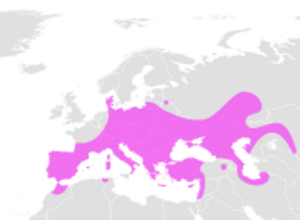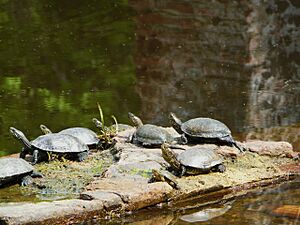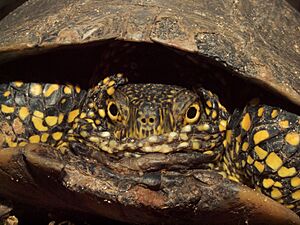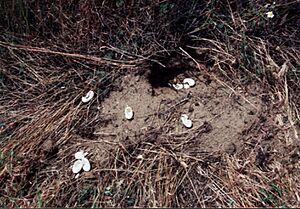European pond turtle facts for kids
The European pond turtle (Emys orbicularis) is a cool freshwater turtle that lives for a very long time! You might also hear it called the European pond terrapin or European pond tortoise. These turtles are found in many parts of Europe, Asia, and North Africa.
Quick facts for kids European pond turtle |
|
|---|---|
 |
|
| A Hellenic pond turtle, found in Albania. | |
| Conservation status | |
| Scientific classification | |
| Genus: |
Emys
|
| Species: |
orbicularis
|
 |
|
| Where the European pond turtle lives. | |
Contents
Types of European Pond Turtles
There are 14 different kinds, or subspecies, of the European pond turtle! Each one has slightly different features or lives in a specific area. Here are some of them:
- Emys orbicularis capolongoi – The Sardinian pond turtle
- Emys orbicularis colchica – The Colchis pond turtle
- Emys orbicularis eiselti – Eiselt's pond turtle
- Emys orbicularis fritzjuergenobstii – Obst's pond turtle
- Emys orbicularis galloitalica – The Italian pond turtle
- Emys orbicularis hellenica – The Western Turkey pond turtle
- Emys orbicularis hispanica – The Spanish pond turtle
- Emys orbicularis iberica – The Kura Valley pond turtle
- Emys orbicularis ingauna
- Emys orbicularis lanzai – The Corsican pond turtle
- Emys orbicularis luteofusca – The Central Turkey pond turtle
- Emys orbicularis occidentalis – The North African pond turtle
- Emys orbicularis orbicularis – The common European pond turtle
- Emys orbicularis persica – The Eastern pond turtle
Naming Turtles
Some of these turtles are named after people who studied them!
- The eiselti turtle is named after a scientist from Vienna named Josef Eiselt.
- The fritzjuergenobsti turtle is named after a German scientist named Fritz Jürgen Obst.
- The lanzai turtle is named after an Italian scientist named Benedetto Lanza.
Where They Live and What They Like
European pond turtles live in southern, central, and eastern Europe, parts of Asia, and some areas of North Africa. In France, there are only a few groups left, and they are becoming rarer. In Switzerland, these turtles disappeared a long time ago, but people started bringing them back in 2010.
Long ago, these turtles lived much further north, even in places like southern Sweden and Great Britain. Now, some groups are trying to bring them back to areas like East Anglia in Great Britain.
These turtles love wetlands, which are like marshy areas or swamps, especially if there are lots of trees and plants around. They also find food in higher, drier areas. They are usually called "semi-aquatic," meaning they spend time in water but also move around on land. They can travel up to 1 kilometer (about 0.6 miles) away from water, and sometimes even up to 4 kilometers (about 2.5 miles)!
Turtle Biology
How They Look
The European pond turtle is a medium-sized turtle. Its top shell, called a carapace, can be anywhere from 12 to 38 centimeters (about 5 to 15 inches) long. The carapace is usually dark brown or black, sometimes with a hint of green. Their heads and legs have yellow spots. The bottom shell, called a plastron, is yellowish.
The temperature where they live affects how much they grow and how big their clutches (groups of eggs) are. Male turtles are usually smaller than females. Males have smaller plastrons, which helps them move around more easily. Females might have different head shapes because of what they eat and how they find food.
What They Eat
European pond turtles eat both plants and animals. This mixed diet helps them digest their food well. When they are young, they mostly eat meat. But as they get older and bigger, they start eating more plants. This is common for many turtles that eat both plants and animals. After the breeding season, when they've used a lot of energy for reproduction, adult turtles might prefer to eat less energetic plant foods to recover.
Reproduction and Nesting
Most freshwater turtles lay their eggs on land, usually close to water. However, some European pond turtles have been known to lay their eggs as far as 150 meters (about 490 feet) from water!
When a female turtle is looking for a good spot to lay her eggs, it can take hours or even days. Once she finds the perfect place, she carefully digs a small pit in the soft ground using only her front legs. After the pit is deep enough, she turns around and gently drops her eggs into the hole. This part can take from 30 minutes to several hours, depending on the weather or if anything disturbs her.
When all the eggs are laid, the female uses her back legs to cover and close the nest. This can take up to four more hours!
Female European pond turtles often return to the same nesting spot year after year if the area hasn't changed. If the surroundings of the nest change, or if the female's diet changes, she might look for a new spot. If she does move, she usually picks a new spot nearby. Sometimes, females will even use an old, abandoned nest if it seems better for her eggs.
Changes in the environment, like thick plants growing over a nest and blocking the sun, can affect the eggs. Since the sex of these turtles depends on the temperature of the nest, cooler, darker conditions can lead to more male turtles being born. This could upset the balance of male and female turtles in the population.
Life Span
The European pond turtle usually lives for 40 to 60 years. Some have even lived for over 100 years, but that's very rare!
Dangers to Turtles
Even though European pond turtles live in many places, they are becoming rare in most countries. One big danger is roads. When roads are built through their natural homes, it breaks up their habitat and makes it hard for them to move around safely. Turtles, especially females looking for nesting spots, can get hit by cars. This is a danger for baby turtles too, as they might wander onto roads. While road accidents aren't the main cause of death, watching these turtles over a long time is important.
Another threat comes from other types of turtles that people have brought into Europe, like the Florida turtles (red-eared sliders). These turtles are bigger and heavier than the native European pond turtles, and they can compete for food and space.
Parasites
Like many animals, European pond turtles can have parasites. These are tiny organisms that live on or inside another animal. Some parasites found in European pond turtles include Haemogregarina stepanovi and different kinds of worms.
Humans and Turtles
In the past, people used to keep European pond turtles as pets. However, now there are laws to protect them. You can't own a wild-caught turtle. You can only own turtles that were born and raised in captivity and are properly registered.
Because of human actions, some European pond turtles have been moved far from where they originally came from. But scientists can use genetic testing to figure out where a turtle's ancestors really lived.
In Ukraine, the European pond turtle is listed under a special agreement called CITES (Convention on International Trade in Endangered Species of Wild Fauna and Flora). This means there are rules about trading these turtles to help protect them.
Images for kids
See also
- List of reptiles of Europe










